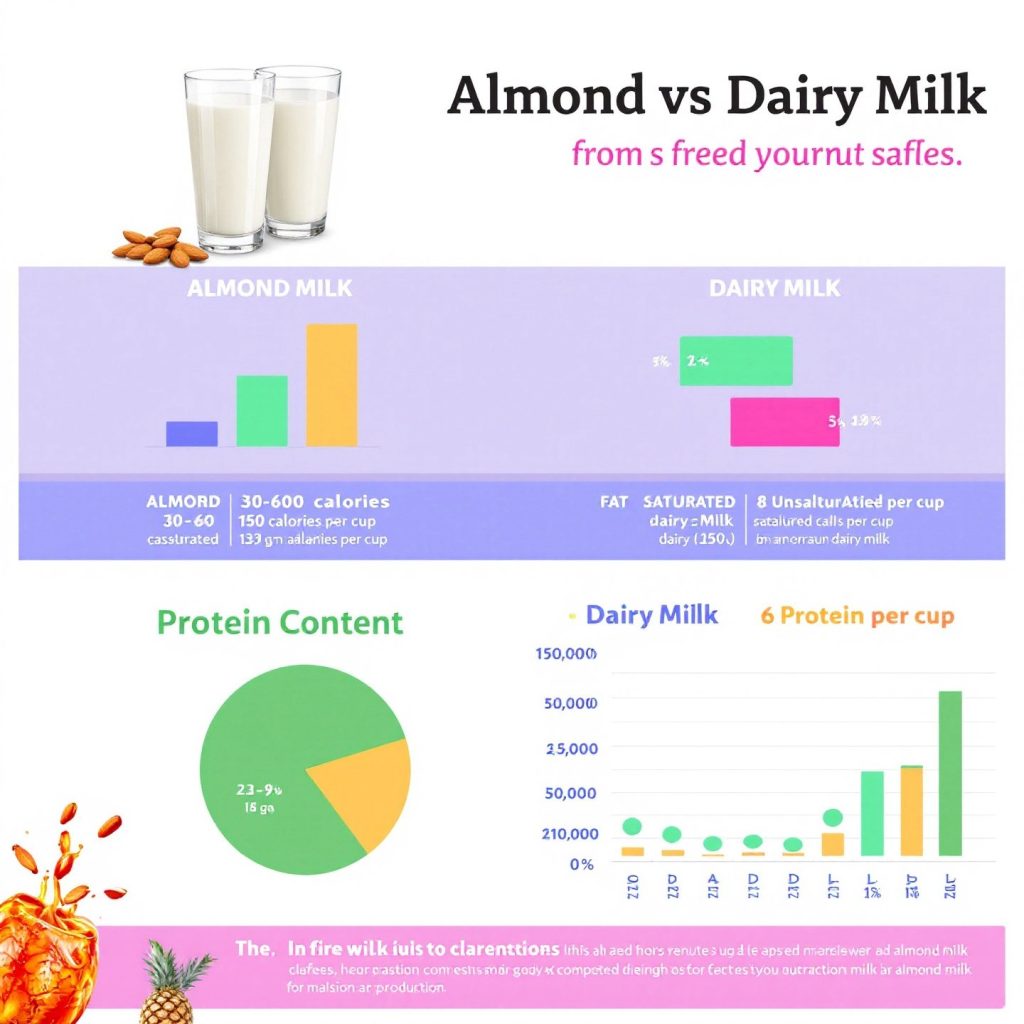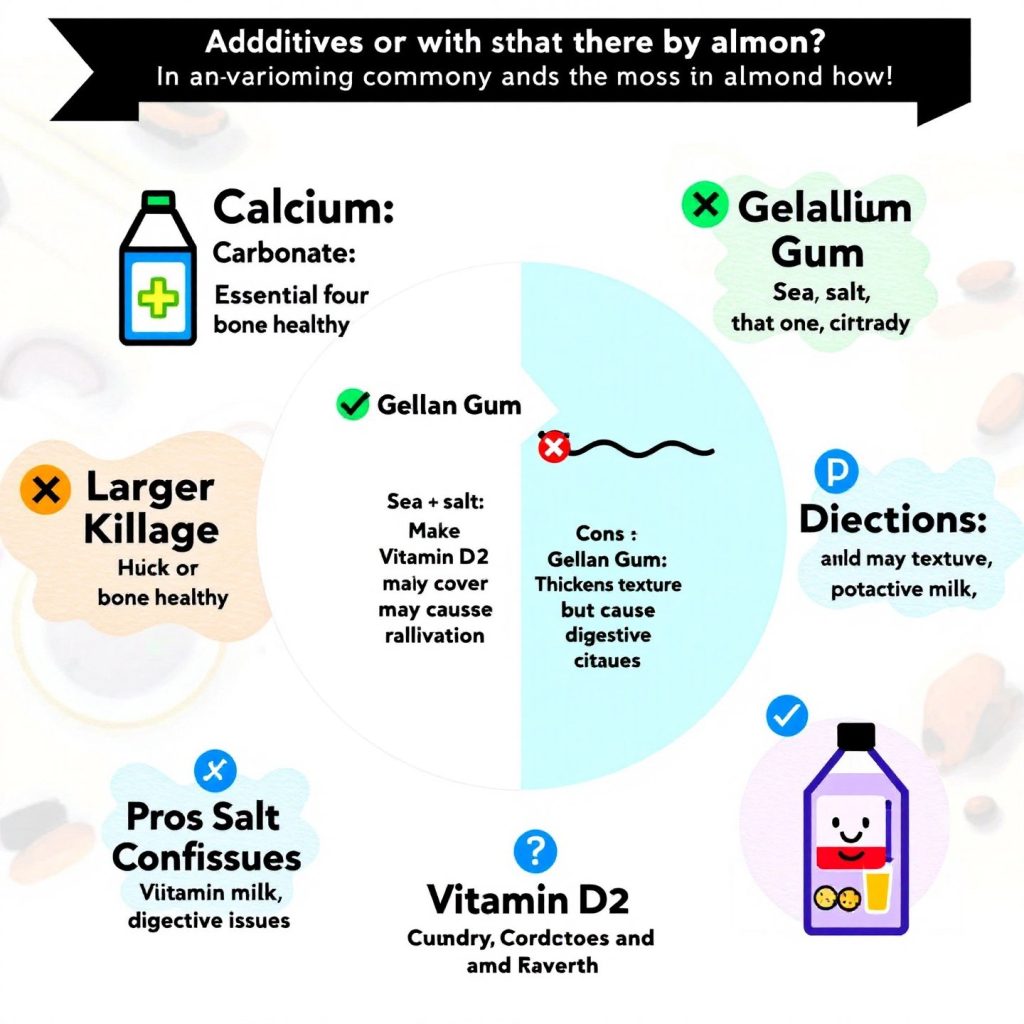Introduction: The Rise of Almond Milk and Its Ingredient Labels
Almond milk has surged in popularity as a preferred dairy alternative among health-conscious consumers. In the U.S., the plant milk market has become a $2 billion industry, with almond milk leading the charge, accounting for a significant portion of sales. This rise can be attributed to a growing awareness of dietary preferences, lactose intolerance, and environmental concerns. Despite its higher cost compared to traditional cow’s milk, almond milk continues to attract consumers who appreciate its taste and perceive it as a healthier option. [Source]
Understanding the ingredients on almond milk labels is crucial for those aiming to make informed dietary choices. The nutrition facts provided on these labels reveal essential information about what you’re consuming, from calorie content to the presence of vitamins and minerals. This guide aims to empower you with the knowledge needed to navigate these labels effectively, helping you compare almond milk to other milk options and select the best product to meet your nutritional goals. By focusing on the details of almond milk ingredients, you can make choices that align with your health objectives and dietary needs.

Infographic comparing almond milk and dairy milk nutrition (AI-generated)
Decoding the Almond Milk Nutrition Label: Key Components
Understanding the almond milk nutrition label is essential for consumers who want to make informed dietary choices. The label provides a snapshot of the beverage’s nutritional profile, highlighting key components such as serving size, calories, fat content, carbohydrates, protein, and vitamins or minerals.
Key Nutritional Elements
The serving size for almond milk is typically one cup (8oz or 240ml), and within this portion, unsweetened almond milk contains approximately 39 calories, making it a low-calorie alternative to dairy milk. The fat content is about 2.5 grams per cup, predominantly consisting of healthy unsaturated fats, which contribute to heart health. Carbohydrates are low, with about 3.4 grams per serving, and the glycemic index is also low, making it suitable for those monitoring their blood sugar levels. Protein content, however, is minimal at just 1 gram per cup, which is significantly lower than cow’s milk, which offers about 8 grams per serving.
Vitamins and Minerals
Almond milk is often fortified to enhance its nutritional value, particularly with calcium and vitamin E. A single cup can provide up to 45% of the daily recommended intake of calcium, crucial for bone health, and over 100% of the recommended daily allowance of vitamin E, which is beneficial for skin health and immune function. These fortifications make almond milk a valuable option for those who are lactose intolerant or choose to avoid dairy for other health reasons.
Comparing Almond Milk to Dairy Milk
When comparing almond milk to dairy milk, it’s clear that while almond milk is lower in calories, protein, and naturally occurring nutrients, it offers a plant-based alternative that can be enriched to meet certain dietary needs. Dairy milk naturally contains balanced nutrients, including essential proteins and fats, which almond milk lacks unless fortified. This comparison highlights the importance of reading the almond milk nutrition label carefully to understand what fortifications are present and how they align with your dietary goals.
In the next section, we will explore the common ingredients found in commercial almond milk and their roles in enhancing the beverage’s taste, texture, and shelf life.
Common Ingredients in Almond Milk: What to Look For
Commercial almond milk is a popular choice for those seeking a dairy-free alternative, and understanding its ingredients is key to making an informed purchase. The almond milk ingredients list typically starts with filtered water and almonds. These foundational ingredients are crucial for creating the base of the milk. However, to enhance its nutritional profile, taste, and shelf life, manufacturers often add a variety of other components.
Core Ingredients and Their Functions
Filtered water and almonds are the primary ingredients, with almonds providing the essential flavor and nutrients. However, the almond content can vary significantly between brands, influencing the milk’s nutritional value. Higher almond content usually means more protein and healthy fats, contributing to a richer taste and creamier texture.
Vitamins and minerals, such as calcium, vitamin D, and vitamin E, are commonly added to almond milk to mimic the nutritional benefits of cow’s milk. These fortifications are particularly beneficial for those looking to substitute dairy milk while maintaining adequate nutrient intake. For instance, calcium fortification helps support bone health, while vitamin E acts as an antioxidant.
Stabilizers and Emulsifiers
To achieve a smooth consistency and prevent separation, almond milk often contains stabilizers and emulsifiers like lecithin and gellan gum. These ingredients enhance the texture and ensure a uniform product. While generally recognized as safe, some consumers prefer to avoid these additives due to personal health concerns.
Sweetened vs. Unsweetened Varieties
A critical distinction in almond milk products is between sweetened vs unsweetened almond milk. Sweetened versions typically contain added sugars or natural sweeteners like cane sugar or agave syrup, enhancing the flavor but also increasing calorie content. Unsweetened almond milk, on the other hand, is a lower-calorie option, ideal for those monitoring sugar intake or following a low-sugar diet.
Choosing between these varieties depends on personal taste preferences and dietary goals. For those seeking to minimize sugar consumption, unsweetened almond milk is the recommended choice. However, sweetened almond milk can appeal to those who prioritize taste and are less concerned about sugar content.
In the next section, we will delve into the additives and fortifications in almond milk, exploring their pros and cons to help you make even more informed choices.

Diagram of common additives in almond milk and their effects (AI-generated)
Additives and Fortifications in Almond Milk: Pros and Cons
Almond milk is often enhanced with various additives and fortifications to improve its nutritional content and consistency. Understanding these components can help consumers make informed choices when selecting almond milk products.
Common Additives and Their Purposes
One of the most prevalent almond milk additives is calcium carbonate, which is used to fortify the milk with calcium, making it comparable to dairy milk in terms of bone health benefits. Vitamin D is another common addition, crucial for calcium absorption and bone health, especially for those who do not get enough sunlight exposure. These fortifications make almond milk a viable alternative for those seeking the health benefits of dairy without the lactose.
Emulsifiers like lecithin and gellan gum are also added to improve the texture and stability of almond milk, preventing separation and ensuring a smooth, creamy consistency. While these additives are generally recognized as safe by food safety authorities, some consumers prefer to avoid them due to potential digestive sensitivities.
Addressing Concerns About Carrageenan
An ingredient that has sparked some debate is carrageenan, a thickening agent derived from red seaweed. It is used in almond milk to enhance texture and prevent separation. While the FDA considers carrageenan safe for consumption, some studies have suggested a potential link to digestive inflammation, though these findings are primarily based on animal studies and not directly applicable to humans. For those concerned, many brands now offer carrageenan-free options to cater to consumer preferences.
Benefits of Fortified Almond Milk
The fortified almond milk benefits are significant, especially for individuals who are lactose intolerant or choose to avoid dairy. Fortified almond milk can be an excellent source of essential nutrients like vitamins A, D, and E, and calcium, supporting overall health and wellness. These additions help bridge the nutritional gap that might occur when eliminating dairy from one’s diet.
In summary, while additives and fortifications enhance almond milk’s nutritional profile and texture, consumers should weigh these benefits against any personal health considerations. In the following section, we’ll explore the sugar content in almond milk and how to navigate these labels effectively.
Sugar Content in Almond Milk: Reading Between the Lines
For those mindful of their sugar intake, understanding the almond milk sugar content is crucial. Almond milk comes in both sweetened and unsweetened varieties, with significant differences in sugar levels. Sweetened almond milk often contains added sugars like cane sugar or syrup, which can raise the calorie count and impact blood sugar levels. This is particularly important for individuals managing diabetes or those looking to reduce their sugar consumption.
Identifying Added Sugars on Labels
To effectively manage your sugar intake, it’s essential to scrutinize the ingredient label. Look for terms such as “cane sugar,” “syrup,” or “sweetener” under the ingredients list. The nutrition facts panel will also indicate the total sugars and added sugars per serving. Unsweetened almond milk typically lists zero grams of added sugars, making it a preferred choice for those aiming to minimize sugar in their diet.
Comparing Sugar Levels Across Brands
The sugar content in almond milk can vary widely between brands and flavors. For example, some sweetened almond milks can have up to 7 grams of sugar per cup, while unsweetened versions usually contain less than 1 gram. It’s beneficial to compare these values across different brands to find an option that aligns with your dietary preferences and health goals.
Choosing Low-Sugar Options
Opting for unsweetened almond milk is an effective way to reduce sugar intake without sacrificing nutritional benefits. These versions maintain the same low-calorie profile and are often fortified with essential vitamins and minerals, such as calcium and vitamin D. By choosing unsweetened almond milk, consumers can enjoy a nutritious beverage that complements a low-sugar diet.
In the next section, we will explore how to identify allergen information and certifications on almond milk labels, aiding in making safe and informed choices.
Allergen Information and Certifications on Almond Milk Labels
When selecting almond milk, understanding allergen information and certifications is essential for ensuring safety and aligning with your dietary preferences. Almond milk labels provide crucial details that help consumers avoid allergens and make informed choices about the products they purchase.
Identifying Allergen Information
Almond milk labels must comply with the Food Allergen Labeling and Consumer Protection Act (FALCPA), which mandates the disclosure of major allergens, including tree nuts like almonds. The label will clearly state “Contains: Almonds” to alert consumers with nut allergies. Additionally, look for precautionary statements such as “May contain traces of other nuts” or “Processed in a facility that also processes peanuts,” which indicate potential cross-contamination. These warnings are vital for individuals with severe allergies, as they provide transparency about the manufacturing environment and potential risks.
Understanding Certifications
Certifications on almond milk packaging, such as organic, non-GMO, and gluten-free labels, offer assurance about the product’s quality and adherence to specific standards. An organic almond milk certification signifies that the product meets USDA organic standards, ensuring it is free from synthetic fertilizers, pesticides, and genetically modified organisms (GMOs). This certification is particularly appealing for consumers seeking environmentally sustainable and health-conscious options.
Non-GMO certification indicates that the product does not contain genetically modified ingredients, aligning with the preferences of consumers who wish to avoid GMOs. Gluten-free labels are essential for individuals with celiac disease or gluten sensitivity, confirming that the product is safe for those avoiding gluten.
Making Informed Choices
When evaluating almond milk labels, consider your dietary needs and preferences. For those with allergies, prioritize products with clear allergen labeling and minimal risk of cross-contamination. For health-conscious consumers, certifications can guide you toward products that meet your standards for organic, non-GMO, and gluten-free ingredients. By understanding these labels, you can confidently select almond milk that supports your health and lifestyle goals.
Next, we will delve into a comparative analysis of ingredient labels from popular almond milk brands, highlighting differences in quality and nutritional content to help you choose the best option for your needs.

Comparison of almond milk brands and their ingredient labels (AI-generated)
Comparing Different Almond Milk Brands: Label Analysis
As the demand for almond milk continues to rise, consumers are presented with a plethora of brands to choose from, each offering unique ingredient profiles and nutritional benefits. Conducting an almond milk brand comparison can help you navigate this variety and select a product that aligns with your dietary needs and preferences.
Ingredient Quality and Nutritional Content
When examining almond milk brands, the ingredient list is a crucial starting point. Brands like Elmhurst and MALK offer almond milk with minimal ingredients, typically just almonds and water, which appeals to those seeking a more natural option. These brands often boast higher almond content, resulting in richer flavor and increased protein levels. However, they may come at a higher price point due to their premium ingredient quality.
In contrast, brands such as Silk and Almond Breeze often include additional ingredients like stabilizers and emulsifiers, such as gellan gum and locust bean gum, to enhance texture and shelf life. While these additives are generally safe, some consumers prefer to avoid them due to potential digestive sensitivities. Moreover, these brands frequently offer fortified options, providing essential vitamins and minerals like calcium and vitamin D, which can be beneficial for those looking to supplement their diet.
Sweetened vs. Unsweetened Options
The choice between sweetened and unsweetened almond milk is another important consideration. Sweetened varieties, like those from Blue Diamond’s Almond Breeze, often contain added sugars, which can increase calorie content and affect blood sugar levels. On the other hand, unsweetened options, such as those from Califia Farms, offer a lower-calorie alternative with minimal sugar content, making them ideal for those monitoring their sugar intake.
Choosing the Best Almond Milk
To select the best almond milk nutrition for your lifestyle, consider your health goals and dietary restrictions. If you’re focused on reducing sugar intake, opt for unsweetened varieties. For those prioritizing nutrient intake, look for brands that offer fortified options with added vitamins and minerals. Additionally, if you have concerns about additives, brands with simpler ingredient lists may be preferable.
Ultimately, the best almond milk is one that meets your nutritional needs while aligning with your taste preferences and budget. By carefully examining ingredient labels and nutritional content, you can make informed decisions that support your health and dietary goals.
In the following section, we will provide practical tips for reading almond milk food labels, helping you make smarter choices in the grocery aisle.
Making Informed Choices: Tips for Reading Almond Milk Food Labels
Navigating the almond milk aisle can be daunting with numerous brands and varieties available. However, understanding how to read food labels effectively can empower you to make healthier choices. By focusing on key elements of the label, you can ensure that the almond milk you select aligns with your dietary needs and preferences.
Key Considerations When Reading Labels
When examining an almond milk label, start with the serving size. This will help you understand the nutritional information relative to the amount you typically consume. Next, check the calorie count to ensure it fits within your dietary goals, especially if you’re monitoring your daily intake.
Look closely at the ingredient list. A shorter list with recognizable ingredients is often preferable, indicating fewer additives. Prioritize products where almonds are one of the first ingredients listed, as this generally signifies a higher almond content, contributing to better nutrition and taste.
Understanding Nutritional Content
Pay attention to the presence of added sugars. Unsweetened almond milk usually contains zero added sugars, making it a healthier choice for those looking to reduce sugar intake. Additionally, consider the fat content, focusing on options with healthy unsaturated fats, which are beneficial for heart health.
Fortified almond milk can be a good source of essential nutrients like calcium and vitamin D, especially if you are using it as a dairy substitute. Ensure that the vitamins and minerals listed align with your nutritional needs.
Making Healthier Choices
Ultimately, choosing healthy almond milk involves balancing taste preferences with nutritional benefits. Consider your health goals, such as reducing sugar intake or increasing nutrient consumption, and select products that best meet these needs. By understanding and comparing almond milk labels, you can confidently choose a product that supports your overall wellness.
In the next section, we’ll recap the importance of understanding almond milk ingredient labels and explore homemade alternatives, empowering you with the knowledge to make informed dietary choices.
Conclusion: Empowering Consumers Through Label Literacy
Understanding the almond milk ingredients label is crucial for making informed dietary choices. By delving into the components and nutritional facts, consumers can better navigate the myriad options available in the market. This guide has equipped you with the knowledge to decipher these labels effectively, ensuring that your choices align with your health goals and dietary preferences.
Applying this newfound literacy in your shopping routine can significantly impact your health. When selecting almond milk, consider factors such as sugar content, additives, and fortifications to choose a product that meets your nutritional needs. Remember, the label is your tool for understanding what you’re consuming, and being aware of these details can help you avoid unwanted ingredients and focus on beneficial ones.
For those looking for greater control over their ingredients, exploring homemade almond milk offers numerous benefits. Making almond milk at home allows you to customize it to your taste and nutritional requirements, avoiding unnecessary additives and sweeteners. This DIY approach not only enhances the quality of your milk but also ensures a fresher, more authentic flavor. Plus, it provides an opportunity to experiment with different flavors and textures, making your almond milk experience truly personalized.
As you continue your journey with almond milk, consider the convenience and health benefits of making it at home. For more insights into creating your own plant-based milks, explore the top plant milk makers of 2025, which can simplify the process and offer eco-friendly solutions for homemade enthusiasts.
In conclusion, mastering almond milk label literacy empowers you to make choices that enhance your well-being. Whether you opt for store-bought or homemade options, the key is to stay informed and prioritize your health with every sip.
Frequently Asked Questions
1. What are the main ingredients in almond milk?
Almond milk primarily consists of filtered water and almonds. It often includes vitamins like calcium and vitamin D, and stabilizers such as gellan gum for texture.
2. Is almond milk a healthy alternative to dairy milk?
Yes, almond milk is a low-calorie, dairy-free alternative. It’s often fortified with nutrients like calcium and vitamin D, making it suitable for those avoiding dairy.
3. How can I identify added sugars in almond milk?
Check the ingredient label for terms like ‘cane sugar’ or ‘sweetener.’ Unsweetened almond milk typically has zero grams of added sugars.
4. What should I look for on almond milk labels regarding allergens?
Labels must state ‘Contains: Almonds’ and may include warnings about potential cross-contamination with other nuts, essential for those with allergies.
5. Are there benefits to making homemade almond milk?
Homemade almond milk allows control over ingredients, avoiding additives and sweeteners, and offers a fresher taste and customizable flavor.
